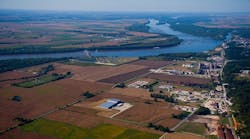It was an act of nature, flooding along the Mississippi in 1993, that brought together 35 counties in Northeast Missouri, Southeast Iowa and Western Illinois.
Under the direction of the Great River Economic Development Foundation (GREDF), in 1996, the counties banded together to recover from the disaster.
And since that beginning the counties have stayed together and were able to achieve a number of milestones including the completion of over 1200 miles of interstate highway which allows for single road travel from Chicago to Kansas City right through this region.
“Out of the biannual Tri State Summit, task force groups have worked on not only transportation but housing, tourism and other regional concerns,” explains GREDF President Marcel Wagner.
It was this level of cooperation that attracted the attention of the USDA with regard to the Great Region designation. To win this designation there must be an economic development plan in place created by a local team with broad regional participation.
“The regional approach is the key to development,” says Wagner. “That's the concept of Great Regions, and that's what this region has done since the flood (of 1993) -- when the region realized there should be a common agenda on things like transportation, work force development and housing."
On Thursday, November 21, the USDA directors from Illinois, Iowa and Missouri traveled to Quincy, Ill. to make mark the occasion creating the eighth Great Region. It is the only one that has multi-state participation.
The creation of the ‘Great Region’ designation was based on helping rural communities come together on a regional basis to develop a strategic plan for building a stronger economy. “By creating a regional focus and increasing collaboration with other Federal agencies, USDA resources will have a larger impact, enabling greater wealth creation, quality of life improvements, and sustainability,” said Agriculture Secretary Tom Vilsack.
In 2001, the USDA, which provides financial support and technical assistance to boost locally- led regional economic development efforts, announced seven ‘Great Regions’ each with their own focus:
- California - Regional food systems, biomass-generated energy, value-added livestock processing and marketing, and alternative energy
- Iowa - Small and emerging agricultural businesses interested in regional food systems and learning about technologies that will enable year-round growing of fruits and vegetables
- North Dakota - Recycling and remanufacturing
- Oregon - Regional food system distribution
- South Carolina - Value-added food processing and agribusinesses
- Vermont - A mixed-use retail and food processing center, a goat milk producers association, and environmental service markets
- Washington/Quinault Indian Nation - Slash materials from the Indian reservation’s forest to provide energy to heat tribal community buildings
The next step for this new region is to develop a specific focus. “Funding could be used for infrastructure or any number of the 40 programs under the USDA,” said Wagner.
Janie Dunning, the Missouri state director for USDA Rural Development, said the designation will be another important tool for regional leaders to help foster continued growth. "We understand the resources of small, rural communities are often insufficient to meet demands when approached on an individual basis, but when communities join together working for common goals, great things can happen," she said. "By taking a regional approach to solving problems, communities can combine assets, expertise and knowledge to respond to challenges."
From a more pragmatic perspective, regional co-operation is an important aspect of why manufacturing companies choose a particular site. It is the combined assets, competencies and capabilities of a region, not physical boundaries that determine which sites are good business locations. And Wagner is quick to point out that while searching for an ideal physical location, such as his area located on the banks of the Mississippi, “it’s great to know that economic co-operation exists on both sides of the river.”



